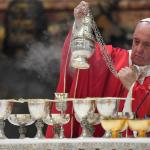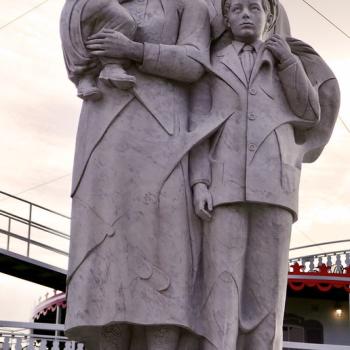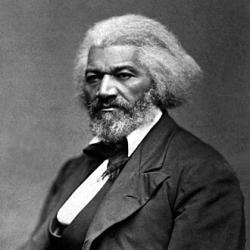There are a lot of members of the Broad Chorus of Catholic Thinkers posting articles, videos and podcasts online. So much in fact that one really doesn’t have the time, energy or computer bandwidth to read all the good things being written up and slapped on a web page. And so I decided to bring examples of a 132 of them together in one post. It consists of bits of Orthodox Catholic thoughts from the Catholic Rigorous Vortex and the Liberal Hippie Catholics and everyone else in-between.
WRN # 18 Cool Tunes From the Broad Chorus of Catholic Thinkers
Easy Access to Tunes and Tweets from the BCCT JULY 29, 2022
The diversity of thought within Catholic teaching, like variety within the strictures of sonnets, is one of its most beautiful features. It is nevertheless important to listen, as much as we can, to a broad chorus of Catholic thinkers. I have found great consolation in the fact that someone holier and smarter than myself has likely asked my questions already; my job is to find them and to listen, and then to make as many people as possible read block quotations about it.
Sharon Kabel , OSB vs. UFO: Stanley Jaki and the Theology of Aliens (June 16, 2021)- OnePeterFive
But of course with so many samples of things to look at in one semi-long post, several nifty, pithy and unique writings and more can get lost in the shuffle. So I decided to take what I gathered and break it up into smaller posts based on themes instead of particular individual Catholic websites. I even added a few other things not found in the larger collage of writings.
In this issue I present to you tunes from the BCCT on…
Religious Life
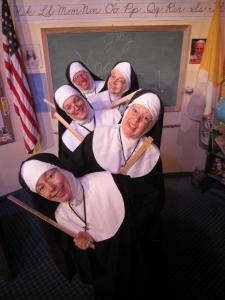
Religious Life Explained:
9 of the Most Well Known Catholic Religious Orders
If you are like me, you can never remember the names of the religious orders that run your school, parish or other institution let alone who founded them, their mottos, coat of arms or characteristics of their spirituality. Well, here is a quick refresher for 9 of the most well known religious orders of the Catholic Church; Franciscans, Carthusians, Jesuits, Benedictines, Salesians, Missionaries of Charity, Dominicans, Augustinians and Carmelites. They were started by some of the most notable men and women of the Catholic faith including St. Francis of Assisi, St. Ignatius of Loyola, St. Benedict and St. Mother Teresa of Calcutta. Or had one of the most famous female saints like the Carmelite order with St. Therese of Lisieux. So next time you forget about that religious order, come back here and refresh your memory. And let us know in the comments about one of your favorite Catholic orders.
9 of the Most Well Known Catholic Religious Orders | Behind the Catholic Counter (aquinasandmore.com)
Religious Life Explained: About Religious Life
In the Catholic Church, the teachings of Saint Francis and Saint Augustine cultivated religious life. Saint Augustine`s teachings are extensively used by religious congregations and Orders of women and men. The teachings of Saint Augustine became a foundation for numerous constitutions of religious Orders in the Catholic Church. Priests, monks, nuns, and hospital sisters all found good motives for hospital work, education, mission work, self-abnegation Saint Augustine`s evangelical wisdom.
Apart from constitutions and charisms, religious life is about supportive community for missionary work, close relationship with the risen Lord in contemplative prayer, and prayerful reading of the Gospel in contextualized situations. It is also about ongoing theological and spiritual formation, spiritual guidance, virtuous living, openness to the marginalized and the poor, dialogue as a way of being drawn to modern-day society, and good and effective religious leadership.
As society evolves, there is a great need for the reformation and the rethinking of organized structures of consecrated life to make provision for new collaborations with God`s people without abandoning the distinctive purpose of every religious Order or congregation.
Laurika Nxumalo Religious Life – A Gift to the Church and Society –(18 December AD 2020) Catholic Stand
Religious Life Explained:Being a Deacon
People ask frequently, “What does it feel like?” If I go by feelings, there is a certain excitement and joy in being able serve the people of God in a very different way, an excitement in being able to encounter people in every stage of their life and be Christ for them.
There is a feeling of awe while serving at the altar and being one very literal step closer to Jesus. There is also a feeling of the weight of responsibility; more and more people are being placed in my care, for whom I have a role in their salvation.
But feelings only can convey part of the whole picture.
Another side of being a deacon is much harder to articulate. It has to do with “becoming.” Perhaps an example is best. Soon after my ordination Mass was over, as I was basking in the glow of being newly ordained, my mother and father asked me to bless them! What an incredibly profound moment that was. A mere two hours earlier, I was their son, and then, with the laying on of hands and prayer of consecration by Bishop Edward B. Scharfenberger, I was no longer just their son, but a son of the whole Church who has power to bless in Jesus’ name.
DEACON ZACHARIAH CHICHESTER A deacon’s life –(Thursday, June 22, 2017) The Evangelist
Religious Life Explained: Contemplative Life
The contemplative life is a radical calling, but the Church recognizes that cloistered religious play an essential role in the work of evangelization through their prayer and witness. Perhaps there is no more striking sign of this esteem than when Pope Pius XI proclaimed St. Thérèse of Lisieux, along with the great Jesuit Missionary St. Francis Xavier as the Universal Patrons of the Missions on December 14, 1927. On October 1, 2019, in his homily at Vespers for the opening of World Missionary Month, Pope Francis explained that St. Thérèse, a Carmelite nun who never left the cloister, “shows us the way: she made prayer the fuel for missionary activity in the world.”
Mike Lewis, A Praying Heart: How Pope Francis intends to save the cloistered life –(OCTOBER 31, 2021) Where Peter Is
Religious Life Explained: Difference Between Nun and Sister
The terms “nun” and “sister” are often used interchangeably. However within Roman Catholicism, there is a difference between the two. Here’s a simple summary of the differences.
A Catholic nun is a woman who lives as a contemplative life in a monastery which is usually cloistered (or enclosed) or semi-cloistered. Her ministry and prayer life is centered within and around the monastery for the good of the world. She professes the perpetual solemn vows living a life according to the evangelical counsels of poverty, celibacy, and obedience. Check out the Carmelite Nuns of Baltimore for example.
A Catholic sister is a woman who lives, ministers, and prays within the world. A sister’s life is often called “active” or “apostolic” because she is engaged in the works of mercy and other ministries that take the Gospel to others where they are. She professes perpetual simple vows living a life according to the evangelical counsels of poverty, celibacy, and obedience.
What’s the difference between a Nun and a Sister (February 2, 2021) Amcatholic4life
Religious Life Explained: Life as a Religious Brother
Religious Life Explained: Making of a Catholic Priest
Religious Life Explained: Monasteries
If the Church is a body, as St. Paul describes it in 1st Corinthians, then the heart of Catholicism here on earth must be the monastery. Its prayers to God for the world are pumped, like blood, throughout the body of Christ giving Christianity life. The monastery foreshadows heaven, providing the regular clergy and laity a taste of our home country; it is where we can be fed on the Word. The monk and the monastery not only create the space for peace but they also serve as a kind of magnet in attracting others to the contemplative life. The monk reminds those in and of this world that the better way is to sit at the feet of Jesus. Along with serving the laity in an iconic fashion, the monks, through their prayers, sustain the Faith. Without them who knows what state Christianity would be in?
Jason Surmiller A Man’s Home Is His Monastery (JANUARY 2, 2020) (crisismagazine.com)
Religious Life Explained: A Nuns Vocation Story
Religious Life Explained: Types
Religious Life Explained: Vows
Religious Life Explained: Women Priests
Yet the times have often favored a female priesthood and never more so than when Christ ordained His first priests, nearly 2,000 years ago. Virtually all the pagan religions of His day had priestesses, and it would have been entirely normal and natural for Him to choose women for this task. He had, moreover, a number of excellent potential candidates, from His own Mother, who accompanied Him at His first miracle and stood with Him as He suffered on the cross, to Mary Magdalene or the women of Bethany. Instead, He chose only men, and He remained immovable on this, continuing right to the end to exhort and train them all, leaving thus a Church which turned out to be safely founded on a rock. From those twelve men a direct line of apostolic succession has given the Catholic Church the bishops and priests it has today.
JOANNE BOGLE Women Priests No Chance Catholic Education Resource Center
Religious Life in Formation: Gregorian Chant
Religious Life in Community/Monastery: Inside Carmelite Monastery
Religious Life in a Monastery: Baking Together
My time with the Trappists revealed much to me. Yet the one thing that I found so impressionable is how much the monastery was/is a microcosm of the Church. This was most tangibly seen (perhaps surprisingly) in the commercial bakery, the industry which supports the life of the monastery. At any given time when the bakery was in operation, you could find the abbot (the head monk), priests, brothers, and lay people working side-by-side in the production of bread and other specialty products. At no time was the abbot given “lighter work” or special treatment. The monks who were both priests and brothers were equals and were usually addressed without a title. The lay persons were primarily in charge of assigning tasks to the monks and patiently gave instruction. In short, each person in the bakery was actualizing a particular vocation within a vocation at that particular moment in time. I write this not to overly spiritualize or glorify the work, since work is, well, work and it can be tedious, boring, and uninspiring. Yet, there is something beautiful when the caste system seems to be non-existent. Of course, each person respected the unique role of the other, yet what permeated was the understanding that no one is better than anyone else. Praying in the chapel and taking out the garbage went hand in hand for the abbot to the postulant and everyone in between. It’s hard not to think that in some way this leveling the field is an exhibition of the universal call to holiness.
Larry Chapp, Father John Gribowich on the Universal Call to Holiness (February 4, 2022) Gaudium et Spes 22
Religious Life in a Monastery: Silent Visitation
Have you ever been to a particularly boisterous and noisy party, and, perhaps getting a bit weary of the noise, slipped off into a quiet room by yourself for a bit and shut the door behind you? Or maybe out into the garden? You can still hear the racket behind you, but it’s distant and you feel for a moment delightfully alone and separated.
I spent last weekend at a monastery – a very, very monastic monastery, obscure and utterly, utterly silent – in the precise middle of exact nowhere, vaguely in the vicinity of the old Umbrian town of Gubbio, of St. Francis and the Wolf fame. This place was rebuilt on top of a small mountain where an ancient hilltop farming village once was. There is little left of the old village now – a place so small that even locals with old family roots have never heard of it.
Hilary White, Three Days of Silence – OnePeterFive
Religious Life as an Autistic Priest
Religious Life in Community: Little Portion Hermitage
Invitation to visit the Monastery
A MONASTIC PILGRIMAGE to the CONTEMPLATIVE HEART OF THE CHURCH
Peace and Good in Christ!
For nearly 2,000 years monasticism has been considered the traditional contemplative and mystical heart of the Church. Only in the recent secularized west has this been lost. Monasteries are dying in the west. BUT, WE ARE REVIVING IT in the SPIRIT with our integrated monastery for ALL STATES OF LIFE.
WE INVITE YOU to make a Pilgrimage to Little Portion Hermitage in the beautiful mountains of Northwest Arkansas to REDISCOVER this POWERFUL GIFT for YOURSELF!
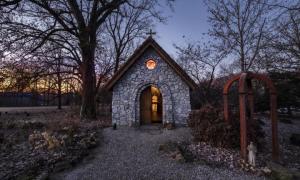
Come with a group or individually for A DAY, or SEVERAL DAYS to immerse yourself in the contemplative heart of Christ in the Church. Our GUEST HOUSE at the Motherhouse is lovely, and the food and fellowship is GREAT! Join us in beautiful chanted Liturgies. Arrange a Spiritual Conference with an experienced monastic. Or just walk the grounds and pray quietly in the Chapel.
Some stay for a day, a week, or even a lifetime!
YOU ARE WELCOME! COME AND JOIN US!
Click HERE to learn more about our way of life!
Click HERE to simply visit the Hermitage!
Contact us HERE.
Religious Life in Community: Making a Habit
Religious Life in a Monastery: Recreation
The schedule in our monasteries includes an activity called the hour of recreation, in which the community gathers in a common room to talk together. It typically follows the evening hour of mental (silent) prayer, and the two share a lot in common. Both require the same attentiveness of heart, both require patient perseverance to gain their reward, and in both that reward is an experience of getting to know the other and being known by them
Recreation is a time set aside for the whole community to gather together for conversation, storytelling, and humor. It’s not a diversion from our life of prayer, but a necessary part of it. St. Teresa-Benedicta was a welcome presence at her community recreations. Her novice mistress tells us “She was a first rate storyteller and could turn even the most trivial incident into a thrilling adventure” (Edith Stein: Life of a Philosopher and Carmelite, pg. 137). St. Thérèse made the community laugh with her rare talent for impersonations (if you can imagine that). No doubt she saw her participation during the hour of recreation as an essential part of living her little way, practicing virtues that go largely unnoticed and in ordinary settings.
Br. Isaiah of the Holy Face What I’ve Learned from Recreation –(June 5th, 2022) Discalced Carmelite Friars
Religious Life in Community: Watch Out for Mountain Lions
One morning at breakfast, though, we were informed that there seemed to be a mountain lion in the vicinity. People had heard it screaming. A day or two later, the report was confirmed.
We weren’t too worried, and continued our evening walks, though avoiding the pasture area where we thought the feline would be more likely to roam.
We had been advised that, if we saw it, we should raise up our arms so as to appear bigger, and slowly back away from it. I also heard that mountain lions aren’t prone to attack people.
The whole thing reminded me of the scene in the original Parent Trap, where the twins trick their dad’s fiancée into making a fool of herself by knocking sticks together as she walked.
It became a little joke throughout my days there, as we reminded each other about danger of the potential intruder.
Sister Christina Marie Neumann Watch Out for Mountain Lions! – Franciscan Sisters of Dillingen (6/3/2022)(ndfranciscans.org)
Religious Life Remembered
The daily life of the Little Sisters of the Poor —“poor among the poor” as their foundress Jeanne Jugan used to say—is focused on serving others, all with the greatest discretion.
And these are not just words. If proof were needed, this message that Fr. Laurent Berthout, of the Diocese of Bayeux, posted on Twitter, will show us.
Indeed, on Monday, April 4, the funeral of a 102-year-old Little Sister of the Poor took place in Caen, France, in the community’s chapel. What a surprise it was for the few faithful present to discover the coffin covered with the American flag, and in the congregation, the presence of three American soldiers who had come from their base in Belgium especially for the occasion.
This is how we learned that the discreet Little Sister Marie-Joseph of the Assumption, who lived in France since the 1950s and carried out her mission in various French and Belgian communities, was in fact American and a soldier!
Soldier, Sister, Centenarian! – Little Sisters of the Poor
Other Related Posts include
Using The Kind Gaze to Look Past Splinters
The Rites of Write(ing) – A List of Catholic Authors and some of their books.
Surfing the Catholic Web
Tweeting to the Choir: A Collection of Tweets


